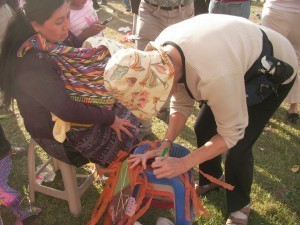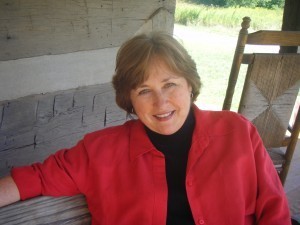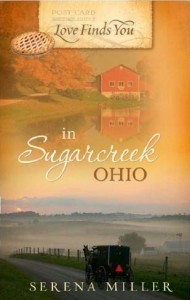Emilie Richards's Blog, page 142
December 12, 2010
Wanda's Lasting Legacy: Snickers Brownie Pie
"'This is your Christian day of rest,' Janya said. 'You bake pie all week, and tomorrow, even if Wanda's is closed, you will be there preparing for Tuesday.'
Wanda stared out the narrow rusty window with its view of scrub and one screeching blackbird. 'Wanda's Wonderful Pies? That's work. But creating a new pie in my own kitchen, even this scrawny, good for nothing excuse for a real kitchen? Well, that's magic, pure and simple. You see the difference?'" (From Sunset Bridge, coming in July 2011)
I have to confess–actually I already did on these pages–that pie has never been my favorite dessert. But how can anybody write about pie or get to know Wanda Gray as intimately as I have, and not take home some of her enthusiasm? I've baked more pies in the years I've been writing the Happiness Key series than I ever made before. And no one at home is complaining, including me.
This holiday when faced with choosing a potluck dish for a Christmas party, I chose pie, of course. And I went right to one of my favorite pie cookbooks to see what would be festive enough. I first discovered Ken Haedrich's Pie: 300Tried-and-True Recipes for Delicious Homemade Pie when I needed a prize to include in my contest to celebrate the arrival of Happiness Key in bookstores. After reading the reviews, I bought one for my winner's basket, and one for myself. I've never regretted that impulse. After all, as Wanda says:
"Any woman who is afraid to be caught eating pie is a woman in need of a brain transplant." (Sunset Bridge)
After careful study–what fun!–I decided to try Ken's Snickers Brownie Pie for my upcoming party. It was decadent and rich enough to serve lots of partygoers, and no surprise, turned out to be one of the hits of the evening. When I mentioned this on my Facebook page, I got requests for the recipe. I tracked down the author's email address and wrote to ask him if I could publish it here. Ken got right back to me and gave his permission. I'm sure Wanda would say pie makes friends out of strangers.
"Nothing was easier to talk about than pie. Wanda figured if countries at war could just sit over pie at the negotiation table and talk about recipes before they delved into who invaded what strip of land, then everything would work out just fine for everybody."(Sunset Bridge)
So, with Ken's permission and my hearty endorsement of this recipe. Here's the recipe. I've made a few changes in Ken's text to make it easier to understand in this shortened format, plus, for the same reason, I haven't included the terrific recipes for either his Graham Cracker Crumb crust or for the Warm Mocha Sauce, both which you can find in his book. Of course you can also substitute similar crusts and chocolate syrups from your grocery store shelf.
Any possible mistakes are mine, not Ken's.
Let me just add that this is a great recipe for a gathering of friends, but likely not something you'd whip up for a quiet dinner for two. It's meant to be shared among many who will appreciate their small, indulgent slice of chocolately heaven.
Snickers Brownie Pie from Pie: 300 Tried and True Recipes by Ken Haedrich
1 large Graham Cracker crust
Brownie Layer:
1/2 cup (1 stick) unsalted butter, cut into pieces
4 ounces semisweet chocolate, coarsely chopped
1 large egg
1 large egg yolk
1/2 cup granulated sugar
1 teaspoon vanilla extract
1/3 cup all-purpose flour
1/2 teaspoon baking powder
1/8 teaspoon salt
Two 3.7 ounces Snickers bars, sliced crosswise about 1/2 inch thick
Prepare the brownie layer: Put the butter in the top of a double boiler set over, not in, barely simmering water. (Emilie's tip: If you're using two stacked saucepans instead of a double boiler, crumple aluminum foil in the bottom one so the top one will rest on the foil without spilling.) As the butter starts to melt, scatter the chocolate on top and leave for 5 minutes, then whisk to smooth. Remove the insert from the double boiler and set chocolate aside to cool for 15 minutes. Preheat the oven to 350 degrees F.
Meanwhile, in a large bowl, beat the egg, egg yolk, and granulated sugar together with an electric mixer on medium speed for 2 minutes. Add the cooled chocolate mixture and vanilla and mix until evenly blended. Mix the flour, baking powder, and salt together in a small bowl. Add to the chocolate mixture and stir until evenly combined. Scrape the batter into the chilled pie shell, smoothing the top with a spoon.
Bake on the center rack of the oven for exactly 18 minutes. Transfer to a wire rack and cool 5 minutes. Arrange the sliced Snickers bars in a single layer over the brownie layer. Set aside to cool.
Peanut Butter Cream
3/4 cup cold heavy or whipping cream
2/3 cup confectioners' sugar, sifted
1 teaspoon vanilla extract
2/3 cup smooth peanut butter
Two 3-ounce packages of full fat cream cheese
Using a chilled medium sized bowl and chilled beaters, beat heavy cream with your mixer until it holds soft peaks. Add the confectioner's sugar and continue to beat until stiff but not grainy. Blend in the chocolate and set aside.
Combine the peanut butter and cream cheese in a large bowl with the mixer until evenly combined. Add almost half the whipped cream and blend on low speed. b'y hand add the remaining whipped cream and fold in until evenly combined. Smooth the peanut butter cream evenly over the snickers slices. Cover with loosely tented aluminum foil and refrigerate for at least 2 hours or overnight.
Drizzle with Ken's warm Mocha Sauce or any good quality chocolate syrup.
"Did anybody's grandmothers make cupcakes? No, that's something a harried mother makes with a mix and takes to her kid's classroom on his birthday, so little John and Jill Classmate don't fight over the size of their pieces. But pie? That's America, that's our heritage, that's our grandmother in the kitchen with a checkered apron and a rolling pin!" (Sunset Bridge)
Many thanks to Ken Haedrich for allowing me to publish this.
December 8, 2010
A Quilter's Heritage
Recently I had the joy of receiving this email from one of my readers, Joyce in Maryland. The story of Aunt Verdie is so lovely that I asked Joyce if I could share it with you. My fondest wish for everyone reading this is that you have or have had an Aunt Verdie in your life.
I'm an avid reader of inspirational novels and after reading each one have a new appreciation for something or someone in my life.
To be honest up until this time I had not read any of your books but now I can't seem to put them down. I can tell by your video on your website and from your books you are very spiritual and have unending love for your family. Because of this, I thought you might enjoy how I came to learn about you as an author and your novels.
Recently, I stumbled, quite accidently, on your novel, Wedding Ring. About two years ago, my great aunt, Verda, passed away at the loving age of 106. As you can imagine she had seen a lot in her life time and kept journals of her life experiences. She was a loving mother to one daughter, Etta Jane, and son-in-law, Gale. Etta Jane and Gale never had children. Although Aunt Verda never had any grandchildren of her own, she had hundreds of children who thought of her as a grandmother.
Aunt Verdie, as many of us called her, was one of the most inspiring people in my life. She was all of 85-90 pounds, extremely talented, and had more love to share than anyone I have ever met. Her talents went far beyond making quilts, reading, and collecting dolls but these were her passion. She never met a stranger and always had a kind word, hug, and sweet smile for everyone.
After the passing of Aunt Verdie's husband and children, she came to live with my mother. Her house was sold to a neighbor and many of her items came to be stored at my mother's home. This past fall, my brother and I started going through some of Aunt Verdie's possessions at the request of our mother. We found trunks and totes full of material she used for quilting. As we continued to go through her possessions we found quilt pattern pieces stuffed in old envelopes, tins, and behind picture frames. The pattern pieces were made out of cardboard, plastic, or any other viable material she could use. In one of her trunks, were several books she obviously had read at some point. One of them was a copy of your novel, Wedding Ring in your Shenandoah Album Series. Our mother had told us prior to sorting through the items if we saw something we wanted to take it as she knew we would cherish it. The book looked very appealing so I picked up the book and put it with a pile of other books I had collected. Later that day the books went home with me. In the few days that followed, I picked up the Wedding Ring book and began reading. I literally could not put the book down. Helen, the character in your book, reminded me so much of Aunt Verdie, that I thought I was reliving the past. Although, Aunt Verdie's personality was a bit different than Helen's, however, the love and passion for quilting were not. She was quick to share her finished labors of love with others.
Many of Aunt Verdie's quilts now cover the beds of family and friends or adorn the walls in their homes including mine. Each time I look at them, it reminds me of the old saying, "A family is quilted and bound with love and grace."
Many thanks to Joyce for sharing Aunt Verdie's wonderful heritage with all of us.
December 5, 2010
Keeping It Simple is Much Too Complicated
 Albert Einstein once said: "Everything should be made as simple as possible, but not simpler."
Albert Einstein once said: "Everything should be made as simple as possible, but not simpler."
Who am I to argue with Al, whose theory of relativity was as simple as 1, 2, 3 to the power of infinity? Last night as I stood in my kitchen among the remnants of a delicious and ultimately overcomplicated meal for eight, I asked myself exactly why simplicity continually eludes me. Why can't I look at a menu ahead of time, figure out that no, none of the dishes I'm serving are complicated, but putting them all together is the very definition of the word?
Exactly when, in the planning of a recipe, a project, a book, do we finally say enough already? This week I said it much too late during my menu planning. I made dishes from scratch that would have been just as good with a few canned assistants. I served two appetizers when one would have been great. I did, to my credit, buy dessert. But that's a relatively new innovation. After all I've been known to make my own bread to stuff a Thanksgiving turkey. And trust me, I know that's not gourmet, that's crazy.
Of course, the same "it's so much better if I start from scratch" mentality applies to novels. Shouldn't every character be completely original, and so fully fleshed out that no matter what the plot throws his way, I, the Master of His Universe, knows exactly how he'll react? Shouldn't I know when my character was toilet trained, weaned from the breast or bottle? Shouldn't I be on speaking terms with his kindergarten teacher?
As simple as possible, but not simpler. Such good advice. So hard to tell the difference.
I'm at the beginning of a new series now, or at least, I hope so. But even if this series goes the way of some good things, there will be another book, another series down the road, and as always, I'll be facing this question. How deep must I dig? How far must I travel?
December will be the perfect month to let my new characters tell me their stories. They'll advise me as I shop for the holidays, explain their theories on where ornaments should go on our Christmas tree, sing Christmas carols with gusto or not. They'll nudge me in the middle of a church service and say, "See if you can get your husband to use 'Lo, How A Rose E'er Blooming,' next Sunday, because I have very little patience and I am heartily sick of 'O Come All Ye Faithful.'" And I will either chastize or agree, depending on how many times I've already sung the latter this month.
The trick, of course, is when to shut them up, when to say, "I, too, have little patience, and I now know everything I want to about you."
Still take it from the woman who cooked a pound of black beans yesterday so that her guests could put a tablespoon or two inside each of their made-from- scratch tortillas.
There is very little chance I will say it soon enough.
December 1, 2010
The Write Way: Sometimes We Just Need A Hand
You're moving right along on your new project. The characters are no longer one dimensional, the plot's moving at just the right pace; then suddenly you sit down at the computer/typewriter/legal pad and nothing happens. You're stuck.
Nothing is more chilling to a writer than an empty page. I outline extensively to avoid them, but even with that weapon in my arsenal, sometimes I still don't know what comes next, or how to put it there.
 Through the years I've developed coping strategies to get me moving again. In hopes one of them will help you, here are some to choose from.
Through the years I've developed coping strategies to get me moving again. In hopes one of them will help you, here are some to choose from.
Blocking Background Noise:
While I can't write to music as many of my colleagues can, I have discovered a few noise-blocking tricks to help me focus. Background noise can pull us out of our stories and make it difficult to jump that abyss to a completed page. Pandora's "ambient" station plays New Age music, complete with environmental sound effects. Pandora is free, as well. If that's too "musical" to suit you, another good bet can be found here at Sleepbot Environmental Broadcast. You'll have to set it up to play on your system, but I followed the iTunes instructions easily. Now I can turn the station on or off from iTunes without going online. More options are available under set up.
Sleep is Your Friend:
Did all that ambient music lull you to sleep? Dreaming can help you move past whatever is blocking you. Power naps alone can sometimes do this, but so can pre-sleep suggestions like: "When I wake up I'll understand better why Mary is refusing to let Joe back into her life." Silly? Not. Suggestions–also called Dream Incubation–often work if you believe they can. The unconscious is your friend.
Brainstorming List:
Ever come to a dead halt in your story because you don't know what should happen next? We've all been there. In previous blogs I've mentioned the List of 20, which I first heard about during a workshop with Linda Lael Miller. Here's a great link to a similar process, only this author suggests a List of 100. While I would find that many options daunting, 20 works perfectly for me. You can use your list to determine your characters' motives, to solve a plot problem, to figure out what should happen next, and even more practical concerns, like how to market the book.
Time yourself:
Finally, an idea I first learned of via Serena Miller. When you sit down to work, set a timer for 45 minutes. When the timer goes off, do something else for the next 15. From experience I've learned this means doing something completely different in another part of the house. Taking a break increases productivity.
Need a timer right there on screen so you can't ignore it? Try Cool Timer from Harmony Hollow Software. I've never had a problem with this free program, although I hesitate to download anything. I set mine to go off to the sound of waves crashing–a wav file I added, also from the internet.
Just a few tips today, but any one of them might help you get past the next hurdle and on to the end of your book. And like the hokey pokey, that's what it's all about.
November 28, 2010
You Have My Sympathy. . . Not
The beginning stages of a novel are often the most fun. Restrictions and limitations? Fuhgeddaboudit. This is the time when a book assumes mythic proportions in the author's mind. If not the best book ever written, this will be the best book the author has ever written, each sentence perfectly constructed, each scene building on the last until the story ends with a rousing and satisfying conclusion. The reader will feel as if he/she has lost friends and yearn for their return. All those things the author always wanted to say but couldn't, will finally be said.
Right now, in true Dickensian imitation, I'm poised somewhere between Great Expectations and Bleak House. On one hand, I still believe my new idea will be, if not my best, certainly one of them. On the other, the reality of the task before me is enough to make me turn off my computer and turn down my covers for a long winter's nap.
In coming days I know I will wrestle with ever aspect of my new idea. But first up, and most important? I must find a way to make my protagonist sympathetic.
Sympathetic characters are a must in every novel. Sympathetic is different from likeable. As readers, we don't have to love everything about the people on the pages we're turning so avidly. But we must connect; we must understand why they act as they do, even if we wish they didn't. We must see at least something of our own struggles inside them.
Unlike many readers I've always enjoyed characters who are not particularly sympathetic as a book opens, but go on to become so as the story progresses. Circumstances bring out the best inside these people. They change as their world changes around them. Tracy Deloche in my Happiness Key series is an example. But even as I shaped her personality and began to write her story, I knew Tracy would have detractors. Some readers have no patience with characters who lack certain virtues. Tracy was self-absorbed, angry at the turn her life had taken, and judgmental. She was, at least at the beginning, hard to root for.
Readers want to root for the important characters in a novel. Some readers, many in fact, won't read further if they don't like a character right at the beginning. From a novelist's viewpoint, however, if we begin with someone who is well nigh perfect, the only conflict we can introduce is external. Things happen to the character, but there's little need to make them happen inside him/her.
Every readers roots for the virtuous protagonist of a novel to win whatever fight they've engaged in. Against the most terrible odds? Even better. But have you ever hoped a true villain would get away without punishment? Did you feel just the faintest twinge of satisfaction when Hannibel Lecter escaped at the end of Silence of the Lambs? If so, you "connected" with this serial killer and cannibal. While you abhored every terrible thing he had ever done, a part of Lecter was sympathetic, because Thomas Harris developed him with great skill and psychological insight.
The major character in the proposal I'm working on is someone who always believed she was living the "right" way and making the right choices. Now, as the book begins, she realizes that at best, she has done the right things for the wrong reasons. Of course I can't say more than that now or why will you read the novel once it's finished? But at the heart of this conflict lies my first big struggle of many with my story. I must find a way to make this character sympathetic, while, at the same time, my readers can see and believe she has lived a fairly unsympathetic life.
As novelists the things we believe about the world are woven on each page of every book we write. I believe people can change for the better, although not without difficulty. My favorite novelists agree with me, so they create characters who change, struggle and grow. Now I'll be required to do this again. But how to keep my readers on the journey?
I don't have an answer yet. That will come as I work, toss, delete, insert, and wring my hands. While I do, I'd love to hear from you right here or on my Facebook page. What can't you forgive a character? What makes characters sympathetic enough that you want to read about their personal struggles? Can you root for a character who is less than perfect? Can you be patient as you read and hope to see a change?
Beginning a novel really is fun, so this time, come along with me I promise to tell you more along the way, but let's make this a conversation. I'm interested in what you think, too.
November 24, 2010
Come Ye Thankful People Come
 "If the only prayer you said in your whole life was thank you, that would be enough." ~Meister Eckhart
"If the only prayer you said in your whole life was thank you, that would be enough." ~Meister Eckhart
"We can only be said to be alive in those moments when our hearts are conscious of our treasures." ~Thornton Wilder
"On Thanksgiving Day, we acknowledge our dependence." ~William Jennings Bryan
"Feeling gratitude and not expressing it is like wrapping a present and not giving it." ~William Arthur Ward
"For each new morning with its light
For rest and shelter of the night
For health and food, for love and friends
For everything thy goodness sends." ~Ralph Waldo Emerson
"You can tell you ate too much for Thanksgiving when you have to let your bathrobe out." ~Jay Leno
"Be with family, be with friends, laugh and eat 'til supper ends. When its over, this mom wishes, don't forget to help with dishes." ~Emilie Richards
HAPPY THANKSGIVING!
November 21, 2010
Conversations With The Dead–Flying Kites in Guatemala
I had the good fortune to visit Guatemala in early 2009, an unusual journey since I'd written about the political struggles in Guatemala in my novel Endless Chain, the second book of my Shenandoah Album series, but had never visited the country. Although only the back story took place in Guatemala, I found it strange to write about a place I'd never seen and experienced. So when our church organized a social justice delegation to be based in Antigua, with excursions into the Mayan Highlands, I gladly signed on. You can read about that trip here and here, or search under my "travel" category for even more.
 Recently when a second trip was planned, I had to say no, since I had promised to help out after the birth of our new grandchild. But my husband went again, camera in hand. And this time, the group was there during the Day of the Dead, November 1st. They took part in the wonderful kite flying festival in the village of Sumpango, and came back with lots of photos. (To see more plus my original Guatemala album, you can access here if you're registered at Facebook.)
Recently when a second trip was planned, I had to say no, since I had promised to help out after the birth of our new grandchild. But my husband went again, camera in hand. And this time, the group was there during the Day of the Dead, November 1st. They took part in the wonderful kite flying festival in the village of Sumpango, and came back with lots of photos. (To see more plus my original Guatemala album, you can access here if you're registered at Facebook.)
If you read Endless Chain, you'll remember a scene in which Sam and Elisa fly a kite to send messages to their departed loved ones. Elisa tells Sam, "Some say the dead know the color of their family's kites and slide down the string to be with them. Others tie messages to the tails, to tell departed family members what has happened during that year and whether they are well. most of all they ask for favors and blessings, because their loved ones are nearer to God than they are."
What a wonderful tradition this is. A day to remember those who have passed before us, a day to be with family and to express gratitude to those who loved us. Although my husband said their group was warned this was a somber day, he found it anything but. Families picnicked on graves, children played, vendors sold roasted corn and kites, and the "barriletes" on display? Well, even in photos, they are amazing. For an even closer look, here's a video of the tradition I found at You Tube.
 My husband and friends sent their own messages. When he showed me the photos and talked about the experience, I found myself wondering who might be waiting to hear from me. My mother certainly, at the head of the line. My grandmothers, one I never knew, one who lived to proudly read my first novels. A friend whose death at age twelve still haunts me.
My husband and friends sent their own messages. When he showed me the photos and talked about the experience, I found myself wondering who might be waiting to hear from me. My mother certainly, at the head of the line. My grandmothers, one I never knew, one who lived to proudly read my first novels. A friend whose death at age twelve still haunts me.
And whom would you send messages to?  What blessings would you ask for? What's happened to you this year that you might want or even need to share?
What blessings would you ask for? What's happened to you this year that you might want or even need to share?
I love this ritual. I love it so much in fact that next year, I think I'll buy my own kite and fly it in remembrance. But how special it must be in the Mayan villages where this tradition continues to be practiced, to be surrounded by family and friends, some of whom might even be remembering the very same loved ones that you are.
November 17, 2010
Love Finds You–An Interview With Author Serena B. Miller
Some years ago I received an email from another minister's wife, an aspiring author. She wanted to know what kinds of issues, if any, I had run into with my husband's congregation because of my novels. She, too, wanted to be a published novelist, but she was looking for exactly the right publishing home. I liked her immediately and we began a correspondence. A year later when she drove to West Virginia from her Ohio home to meet me at a conference, we were already friends and have remained so through the years.
 I recognized Serena's talent immediately, as did everyone who read whatever she wrote. Her stories about her home, family and life jumped off the computer screen into my heart. Her quiet wisdom, fabulous sense of humor, and ability to be honest while still remaining positive were inspiring to me. Are still inspiring, in fact. I knew it was just a matter of time until the "right" book hit the "right" literary agent or publisher, and then, the sky would be the limit. Sure enough, her first novel, Love Finds You in Sugarcreek, Ohio, a fascinating exploration of Amish life from Summerside Press, is the winner I knew it would be. And she's already on contract for more.
I recognized Serena's talent immediately, as did everyone who read whatever she wrote. Her stories about her home, family and life jumped off the computer screen into my heart. Her quiet wisdom, fabulous sense of humor, and ability to be honest while still remaining positive were inspiring to me. Are still inspiring, in fact. I knew it was just a matter of time until the "right" book hit the "right" literary agent or publisher, and then, the sky would be the limit. Sure enough, her first novel, Love Finds You in Sugarcreek, Ohio, a fascinating exploration of Amish life from Summerside Press, is the winner I knew it would be. And she's already on contract for more.
Serena and I attend very different churches in very different places. Serena and I write for different publishers, in different genres. But Serena and I have learned that these things are less important than friendship and a good book.
And speaking of a good book? Serena has promised to send one commenter on this post an autographed copy of her novel. So be sure to add your comment below for a chance to win. Random.org will choose the lucky winner next week and in the meantime, Serena will answer your questions, too.
It's with great pleasure that I introduce my friend Serena B. Miller, and her wonderful first novel.
 1–You've had such a diversity of life experiences. Tell us why you chose to write about the Amish for your first novel. What drew you toward exploring their unique lifestyle?
1–You've had such a diversity of life experiences. Tell us why you chose to write about the Amish for your first novel. What drew you toward exploring their unique lifestyle?
Five years ago a group of Old Order Amish migrated to our farming community in southern Ohio. Eventually, a local Amish man invited us to his house to meet his wife and children. Over time a strong friendship evolved. One day my literary agent said, "Okay. Your name is Miller. You live in Ohio. You have Amish friends. How about writing an Amish novel?" The minute she suggested it, I knew it was something I wanted to do.
2–What did you learn from your research that you could take into your own life and use?
The emphasis on family and faith molds every decision the Amish make, and has validated the importance of those two things in my own life.
I'm also greatly impressed with their children, who are the happiest, calmest, best-behaved kids I've ever seen, and yet I've never observed a parent so much as raise their voice to them.
3—Why do you think that is?
In part, it's probably the lack of TV and electronics in their lives. They seem to have a much longer attention span than non-Amish children.
Also, every child has some job to accomplish that adds to the family or community good. Even the very young (from about two years old) are taught to accomplish small daily tasks. I believe this builds a measure of self-worth that helps eliminates the need to act out to gain attention.
At an Amish wedding I attended recently, there were at least a hundred children present and not one was a disruption. Instead, each had a small job to perform and seemed to take great pride in carrying it out. My sons are grown, but if I still had young children, I would definitely try to follow the Amish pattern as closely as possible.
4–I loved your book and felt that while it is classified as an inspirational novel, you never preached to your readers. The characters' faith–or lack of it–was part of who they were and not inserted because it "had" to be there. Do you have any writing tips for others who might want to write inspirational stories?
No one wants to be preached at. A mini-sermon dropped into the middle of a novel sets my teeth on edge. On the other hand, everyone loves to watch the drama of someone struggling to do what's right, especially if it isn't in their best interest.
My theme scripture was about showing hospitality to strangers. I deliberately wove that scripture so deeply into the personalities of the three elderly Amish aunts that it affected everything they did–including creating complications and conflict. Instead of preaching a mini-sermon about hospitality, I took a hard scripture and watched it play out in my character's lives.
I guess what I'm trying to say is part of writing the kind of inspirational novel that people don't want to toss across the room is to practice what we learn in our writer workshops and classes about "show don't tell."
I also feel it wouldn't hurt if we practiced that in our lives as well—but now I'm preaching.
5–Your blend of Amish and "English" characters was seamless. You knocked down the boundaries between neighbors and made everyone simply people. I know you had help with your research from Amish neighbors. Along the way did you gain any secrets on how people can reach out and learn from people whose "cultures" are different from their own?
Oh gosh. The older I get, the more I'm convinced that people are just people—no matter where they live or what language they speak. One of my Amish friends' greatest fears is that her teenage sons will get hooked on drugs. I've raised three sons and I can commiserate. She's worried about her health and has been trying some new herbal supplements. I'm worried about my health, and I'm interested in if they're helping. Her husband is working way too hard and she's looking for ways in which she can bring in some income. Me too! So we discuss her Teddy Bear-making business and my writing business. She has a special cookie recipe she's proud of. I copy it down. I have a new bread recipe I swear by. She copies it down.
Family. Health. Work. Food. These are constants in any culture. These subjects can provide endless sources of conversation during which friendships are established.
But before anything else, respect has to be absolutely paramount. When I visit my Amish friends, I dress plainly, speak softly, wear no make-up, and never, ever ask to take photos.
6—Amish fiction, a relatively new genre, has become incredibly popular in the past few years. Why do you think this is?
My theory is that these are scary times and the simplicity and timelessness of the Amish culture is appealing. Escaping into a novel about the Amish lifestyle is deeply comforting to many readers.
My Amish friends, however, are mystified by outsiders' fascination with them. They watch our culture and wonder why on earth we don't just simply turn off our TV, plant a garden, help our neighbors, love our spouses, go to church, and pay attention to our kids.
After having spent so many hours with them—I believe they have a point.
November 14, 2010
Jumping Off the Merry-Go-Round

Merry Go Round From Benutzer KMJ
There I was reading Everyday Foods magazine while my granddaughter chattered beside me. "I get this at home," I told my son-in-law, "but I haven't had time to read it in a year." There was a silence, then he said, "You know, something's wrong with that, Mom."
Indeed there is.
First, on the subject of Everyday Foods. Great little magazine. Great simple recipes. Lots of vegetarian fare for those of us interested in at least cutting down on meat. It's compact, easy to get through in ten minutes, but despite that, each month when it arrives, I simply stack it to look at later. Only "later" rarely comes.
I'm not imagining that life moves faster these days. Before arriving to be with family in Ohio last week, I was rising before the sun, running full speed, and falling exhausted into bed at midnight. You might well have been, too. Most of us are working harder, worried about keeping jobs because so many people are losing them. Lending a hand where it's most needed while our country fights on two battlefields and friends and family are losing homes to banks with little interest in setting things right.
It's a difficult time for so many. So we run faster, farther, harder. Sometimes we find ourselves back where we started when the day comes to a close.
There is definitely something wrong with getting a magazine I never take the time to read. I guess I have two choices. I can end my subscription, or I can put my feet up once a month, page through and pull out the recipes I'd like to try next. Simplify my life, or take a little time off to dream and plan. Both have merit.
What doesn't have merit? Stacking magazines to read someday when I have the time. I needed a reminder that life happens now, not later. Thanks to my son-in-law, I got one.
I think maybe I'll go make chicken noodle soup from scratch before I proof the edits of my new book. There was this wonderful recipe on page . . .
November 10, 2010
The Places We Leave Behind
 I've been lucky, although for a long time I didn't notice. While I am clearly a small town/rooted for generations/never need to move kind of woman, I have only lived in one small town, where we had no family ties. We moved on after six years. I am married to a minister, and moving comes with the territory.
I've been lucky, although for a long time I didn't notice. While I am clearly a small town/rooted for generations/never need to move kind of woman, I have only lived in one small town, where we had no family ties. We moved on after six years. I am married to a minister, and moving comes with the territory.
Since I married my husband I have lived in seven states, sojourned in another as well as Australia, and I've lived in both the north and south of the Old Dominion, which is, as anyone who's done that knows, like living in two different countries. I've lived in suburbia, on a mountain top, big cities, small cities and places in between.
Recently I had the opportunity to return to one of my former homes, Cleveland, OH, where two of my married children remained. I'm here to welcome a new family member, Allison Nicole, who made her appearance early Monday morning. I won't regale you with tales of how perfect she is, how precious it is to rock a newborn and watch as her expressions change and the world begins to form for her. It defies words. There is no experience like it.
Being here is special in many ways. My children and grandchildren. Getting together with wonderful writer friends to catch up on each others' lives. Two well attended booksignings. A chance for some heart to heart talks with the people I love.
Somewhere in the midst of this I realized just how lucky I have been. We have moved many times, but we've never really left home. Each time I return to a place where I once paid taxes, attended church, visited the library, took my children to school, I'm home again. I did, indeed, put down roots for a lifetime.
Over and over and over again.
I hope that wherever you are, you are home, as well.






